Apple’s highly anticipated Vision Pro headset, resembling ski goggles, has encountered a significant hurdle ahead of its launch. YouTube, Netflix, and Spotify, three of the most dominant forces in digital entertainment, have opted not to release native apps for the device. This decision has stirred a mix of reactions and speculations within the tech community.
Key Highlights:
- YouTube, Spotify, and Netflix will not offer native app support for the Apple Vision Pro at its launch.
- These services can still be accessed via Safari, but this workaround might not provide the optimal user experience.
- Other major apps, including those from Meta Platforms Inc. (like Facebook and Instagram), are also not set to be compatible with the Vision Pro.
- The tech community is discussing various workarounds and the broader implications of this decision.
- Despite these setbacks, several other major entertainment services, such as Disney+, HBO Max, and Amazon Prime Video, have pledged support for the Vision Pro.

Background of the Decision
YouTube and Spotify’s decision to forgo native app development for Apple’s Vision Pro is notable, especially given the absence of a Spotify app on similar devices like Meta’s Quest headset. YouTube, however, does support the Quest. The motivations behind these decisions are shrouded in speculation, ranging from business strategies to technical challenges. The historical context of Spotify’s strained relationship with Apple, particularly regarding App Store policies, adds another layer to the decision-making process.
Apple’s Vision Pro: Potential and Hurdles
The Vision Pro is Apple’s ambitious foray into the mixed-reality headset market, aiming to offer an immersive experience that combines elements of AR and VR. However, the lack of support from major streaming services raises questions about its potential success.
- Content is King: In the world of digital media, content availability is a key driver of hardware success. The absence of popular apps could limit the appeal of the Vision Pro to a broader audience.
- Apple’s Ecosystem Strength: Apple has a strong track record of building successful ecosystems around its products. The Vision Pro could leverage this strength, focusing on areas like education, healthcare, and specialized applications where Apple can exercise more control.
- Future Compatibility: It’s possible that these major services are adopting a “wait and see” approach and may develop apps for the Vision Pro if it gains sufficient market traction.
Consumer Reactions and Speculations
The tech community is actively discussing the impact of this development. Some speculate financial and strategic reasons, while others focus on the dynamic between Apple and app developers. The consensus seems to be that this could be a significant hurdle for the Vision Pro, with many highlighting the importance of native app support for a device’s success.
The Vision Pro’s Market Position
Despite the setback of losing support from these major platforms, the Apple Vision Pro still promises an immersive audio-visual entertainment experience. Set to be available for pre-order and in-store on February 2, 2024, the device remains a significant release for Apple. It marks their latest venture into the mixed-reality headset market, a space that is becoming increasingly competitive.
The Apple Vision Pro’s launch is clouded with uncertainties due to the snub from major streaming platforms. While this presents a challenge, the device still holds potential in the mixed-reality market, especially with the support of other entertainment services. The tech community’s response and adaptability, along with the device’s inherent capabilities, will ultimately dictate the success of the Vision Pro in the evolving landscape of digital entertainment.


















